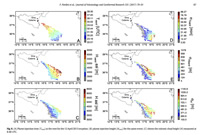Retrieval and intercomparison of volcanic SO2 injection height and eruption time from satellite maps and ground-based observations
Pardini F., M. Burton, M. de’ Michieli Vitturi, S. Corradini, G. Salerno, L. Merucci, & G.D. Grazia (2016).
Journal of Volcanology and Geothermal Research, 331, 79-91, http://dx.doi.org/10.1016/j.jvolgeores.2016.12.008
Abstract
Syneruptive gas flux time series can, in principle, be retrieved from satellite maps of SO2 collected during and immediately after volcanic eruptions, and used to gain insights into the volcanic processes which drive the volcanic activity. Determination of the age and height of volcanic plumes are key prerequisites for such calculations. However, these parameters are challenging to constrain using satellite-based techniques. Here, we use imagery from OMI and GOME-2 satellite sensors and a novel numerical procedure based on back-trajectory analysis to calculate plume height as a function of position at the satellite measurement time together with plume injection height and time at a volcanic vent location. We applied this new procedure to three Etna eruptions (12 August 2011, 18 March 2012 and 12 April 2013) and compared our results with independent satellite and ground-based estimations. We also compare our injection height time-series with measurements of volcanic tremor, which reflects the eruption intensity, showing a good match between these two datasets. Our results are a milestone in progressing towards reliable determination of gas flux data from satellite-derived SO2 maps during volcanic eruptions, which would be of great value for operational management of explosive eruptions.
http://www.sciencedirect.com/science/article/pii/S037702731630244X


